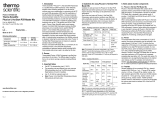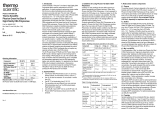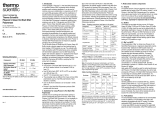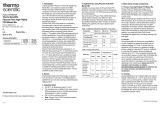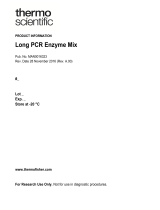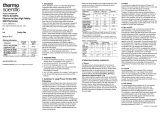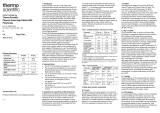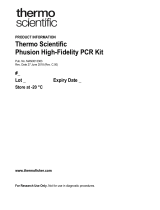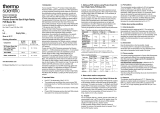
Phusion™ Plus Green PCR Master Mix
Catalog Numbers F632S, F632L, F632XL
Pub. No. MAN0025048 Rev. A.0
WARNING! Read the Safety Data Sheets (SDSs) and follow the handling instructions. Wear appropriate protective eyewear,
clothing, and gloves. Safety Data Sheets (SDSs) are available from thermofisher.com/support.
Product description
The Thermo Scientific™ Phusion™ Plus Green PCR Master Mix is a ready-to-use mixture of DNA polymerase, salts, magnesium, and
dNTPs for ecient PCR amplification. The master mix is ideal for applications where accuracy is important (cloning, sequencing, site
directed mutagenesis).
Two tracking dyes and a density reagent are pre-added to the master mix for direct loading of PCR products onto gels.
The master mix contains the Phusion™ Plus DNA Polymerase, a proofreading DNA polymerase that combines a novel Pyrococcus-like
enzyme with a processivity-enhancing domain and universal primer annealing feature.
The polymerase is inactive at ambient temperatures due to an Abody™ molecule mediated hot start mechanism, allowing reaction setup
and storage of pre-assembled PCR reactions at room temperature. Enzyme activity is restored after the initial denaturation step.
Primer annealing is performed at 60°C because proprietary additives in the reaction buer stabilize primer-template duplexes during
annealing, and eliminate the need to optimize annealing temperature for each primer pair.
The polymerase possesses the following characteristics:
• 5´→3´ DNA polymerase activity.
• 3´→5´ exonuclease activity.
• Generates blunt end amplification products.
•Amplifies up to 10 kb from genomic DNA, and 20 kb from low complexity DNA.
• Works with both AT and GC rich targets (Phusion™ GC Enhancer is provided for amplicons with >65% GC content).
• >100X fidelity compared to Taq polymerase.
Contents and storage
Component F632S
100 reactions
F632L
500 reactions
F632XL
4 × 500 reactions Storage
Phusion™ Plus Green PCR Master Mix 2 × 1.25 mL 10 × 1.25 mL 40 × 1.25 mL
–25°C to –15°CPhusion™ GC Enhancer 1.25 mL 4 × 1.25 mL 16 × 1.25 mL
Water 2 × 1.25 mL 10 × 1.25 mL 40 × 1.25 mL
General guidelines
• Use 98°C for denaturation.
• Use 15–30 s/kb for extension.
• The polymerase cannot read through dUTP-derivatives or dITP in the template strand, thus primers and dNTP mixes containing such
nucleotides are not compatible.
• Carefully mix and centrifuge all tubes before opening to ensure homogeneity and improve recovery. Prepare a master mix for the
appropriate number of samples to be amplified.
• Take precautions to avoid cross-contamination by using aerosol-resistant barrier tips and analyzing PCR products in a separate area
from PCR assembly.
USER GUIDE
For Research Use Only. Not for use in diagnostic procedures.

Required materials not supplied
• Template: genomic DNA, plasmid, phage DNA, cDNA
• Forward and reverse primers
• TopVision Agarose Tablets (Cat no. R2801)
• GeneRuler 1 kb DNA Ladder (Cat.no. SM0311)
• 0.2 or 0.5-mL nuclease-free microcentrifuge tubes
• Water, nuclease-free
Perform PCR
1. Prepare reaction by adding the following components in the order listed in the following table.
Component 20 µL rxn 50 µL rxn Final conc.
2X Phusion™ Plus Green PCR Master Mix [1] 10 µL 25 µL 1X
Forward primer x µL x µL 0.5 µM [2]
Reverse primer x µL x µL 0.5 µM [2]
Template DNA x µL x µL 0.01–10 ng plasmid
5–100 ng genomic DNA
5X Phusion™ GC Enhancer [3] 4 µL 10 µL 1X
Water, nuclease free add to 20 µL add to 50 µL —
[1] Provides 1.7 mM MgCl2 at 1X concentration.
[2] Reduce the primer concentration to 0.2 µM final concentration when amplifying >5 kb targets from genomic DNA and for multiplex reactions.
[3] (Optional) recommended only for targets with >65% GC content.
2. Run a thermal cycler program set to the following parameters according to the protocol to be performed.
a. 3-step protocol
Cycle step Temp. Time Cycles
Initial Denaturation 98°C 30 s 1
Denaturation
Annealing
Extension
98°C
60°C
72°C
5–10 s
10 s
15–30 s/kb
25–35
Final extension 72°C
4°C
5 min
Hold
1
Hold
b. 2-step protocol (for primers >30 nt in length)
Cycle step Temp. Time Cycles
Initial Denaturation 98°C 30 s 1
Denaturation
Annealing/extension
98°C
72°C
5–10 s
15–30 s/kb 25–35
Final extension 72°C
4°C
5 min
Hold
1
Hold
2 Phusion™ Plus Green PCR Master Mix User Guide

Optimization strategies
Primers
• Design 18- to 35-mers with 40–60% GC content. Avoid primer pairs with complementarity at 3' ends or >10°C melting temperature
(Tm) dierence.
• Verify primer complementarity to a single template region using programs for sequence alignment. Online primer design programs
such as the Invitrogen™ OligoPerfect™ Designer can be helpful.
• Recommended final primer concentration is 0.5 µM and can be varied in a range of 0.1–1.0 μM, if needed. Lower primer
concentrations (0.2 µM final) are recommended for amplification of >5 kb targets from high complexity DNA and multiplex reactions.
Template
•Low complexity DNA: Optimal amount of low complexity DNA (plasmid, phage or BAC DNA) is 0.01–10 ng per 50 μL reaction,
although it can be varied from 0.1 pg to 50 ng per 50 μL reaction.
•Genomic DNA: Optimal amount of genomic DNA is 5–100 ng per 50 μL reaction, although it can be varied from 0.1–250 ng per
50 μL reaction. Higher template amount is recommended for long targets.
•cDNA: Optimal amount of cDNA is 0.1–1 μL of the first-strand reaction mixture per 50 μL reaction.
Cycling parameters
The total number of PCR cycles can vary from 15 to 40, depending on target length and template amount. For low complexity templates
20–25 PCR cycles is typical; 30–35 cycles are recommended for genomic DNA.
Denaturation
• Use 98°C for denaturation. Make sure that heated lid temperature is set several degrees above 98°C to avoid sample condensation.
• 30-second initial denaturation at 98°C is sucient for most templates. The initial denaturation time can be increased up to 5 minutes
if necessary.
Annealing
• Due to unique isostabilizing molecules in the reaction buer, 60°C annealing temperature works for most primers.
• The 2-step protocol is recommended when primers without non-complementary parts are >30 nt in length, e.g., primers for site-
specific mutagenesis. In the 2-step protocol the combined annealing/extension step should be performed at 72°C.
• If amplification does not give satisfactory results, we recommend a temperature gradient. The annealing temperature can be
optimized using Applied Biosystems™ thermal cyclers, such as the ProFlex™ PCR System or the VeritiPro™ Thermal Cycler featuring
VeriFlex™ technology.
Extension
• Extension time depends on amplicon length and complexity. For low complexity DNA (e.g., plasmid, phage or BAC DNA) use an
extension time of 15 seconds per 1 kb. For high complexity genomic DNA 30 seconds per 1 kb is recommended.
• The extension step can be prolonged up to 90 sec/kb for targets up to 5 kb without negative eect on specificity. This allows to
amplify shorter and longer amplicons together using the same protocol.
MgCl2
Phusion™ Plus reaction buer provides 1.7 mM MgCl2 in the final reaction. If the primers and/or the template contain chelators such as
EDTA or EGTA, the apparent Mg2+ optimum may be shifted to higher concentrations. MgCl2 concentration can be increased up to 4.5 mM
final concentration in such cases.
Phusion™ Plus Green PCR Master Mix User Guide 3

Troubleshooting
Observation Possible cause Recommended action
No product or low yield Sub-optimal cycling parameters. Run a temperature gradient to determine optimal annealing
temperature.
Increase the total number of cycles.
Problem with reaction mix. Repeat the PCR and make sure that there are no pipetting errors.
Check primer design and concentration. Do not use primers
containing dUTP or dITP.
Titrate template amount, both not enough and too much template can
compromise PCR results.
Non-specific products or smeared
bands
Sub-optimal cycling parameters. Run a temperature gradient to determine optimal annealing
temperature.
Decrease extension time.
Reduce the total number of cycles.
Primer concentration too high. Reduce primer concentration.
Documentation and support
Customer and technical support
Visit thermofisher.com/support for the latest service and support information.
• Worldwide contact telephone numbers
• Product support information
– Product FAQs
– Software, patches, and updates
– Training for many applications and instruments
• Order and web support
• Product documentation
– User guides, manuals, and protocols
–Certificates of Analysis
– Safety Data Sheets (SDSs; also known as MSDSs)
Note: For SDSs for reagents and chemicals from other manufacturers, contact the manufacturer.
Limited product warranty
Life Technologies Corporation and/or its aliate(s) warrant their products as set forth in the Life Technologies' General Terms and
Conditions of Sale at www.thermofisher.com/us/en/home/global/terms-and-conditions.html. If you have any questions, please
contact Life Technologies at www.thermofisher.com/support.
Thermo Fisher Scientific Baltics UAB | V.A. Graiciuno 8, LT-02241 | Vilnius, Lithuania
For descriptions of symbols on product labels or product documents, go to thermofisher.com/symbols-definition.
The information in this guide is subject to change without notice.
DISCLAIMER: TO THE EXTENT ALLOWED BY LAW, THERMO FISHER SCIENTIFIC INC. AND/OR ITS AFFILIATE(S) WILL NOT BE LIABLE FOR SPECIAL, INCIDENTAL, INDIRECT,
PUNITIVE, MULTIPLE, OR CONSEQUENTIAL DAMAGES IN CONNECTION WITH OR ARISING FROM THIS DOCUMENT, INCLUDING YOUR USE OF IT.
Revision history: Pub. No. MAN0025048
Revision Date Description
A.0 2 April 2021 Baseline for revision.
Important Licensing Information: These products may be covered by one or more Limited Use Label Licenses. By use of these products, you accept the terms and conditions of all
applicable Limited Use Label Licenses.
©2021 Thermo Fisher Scientific Inc. All rights reserved. All trademarks are the property of Thermo Fisher Scientific and its subsidiaries unless otherwise specified.
thermofisher.com/support | thermofisher.com/askaquestion
thermofisher.com
2 April 2021
/
